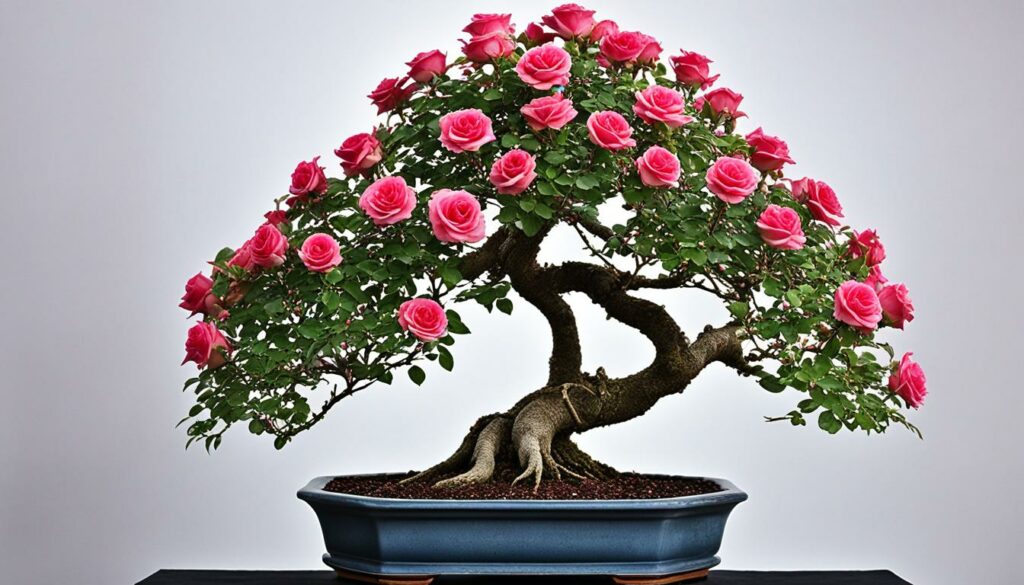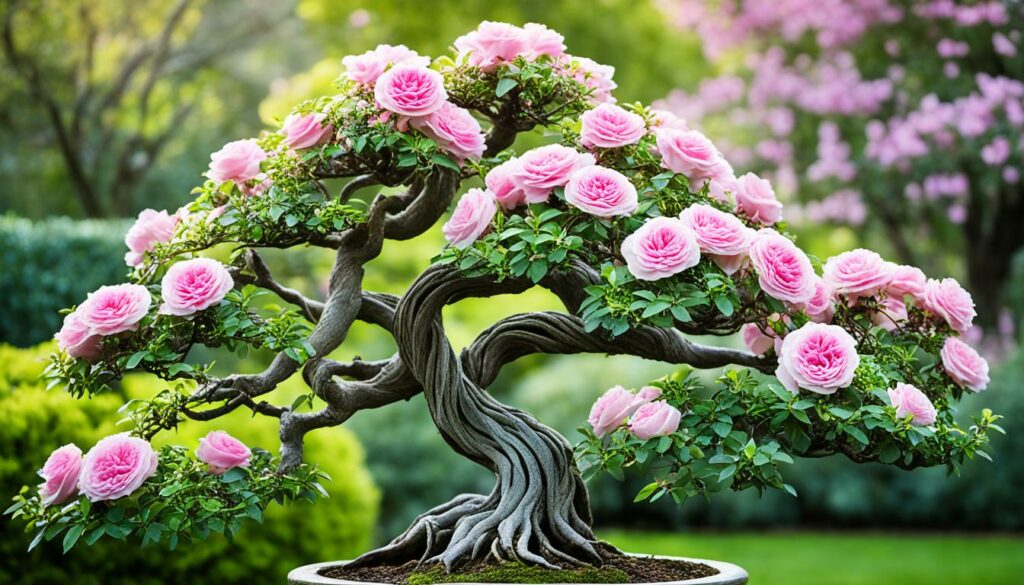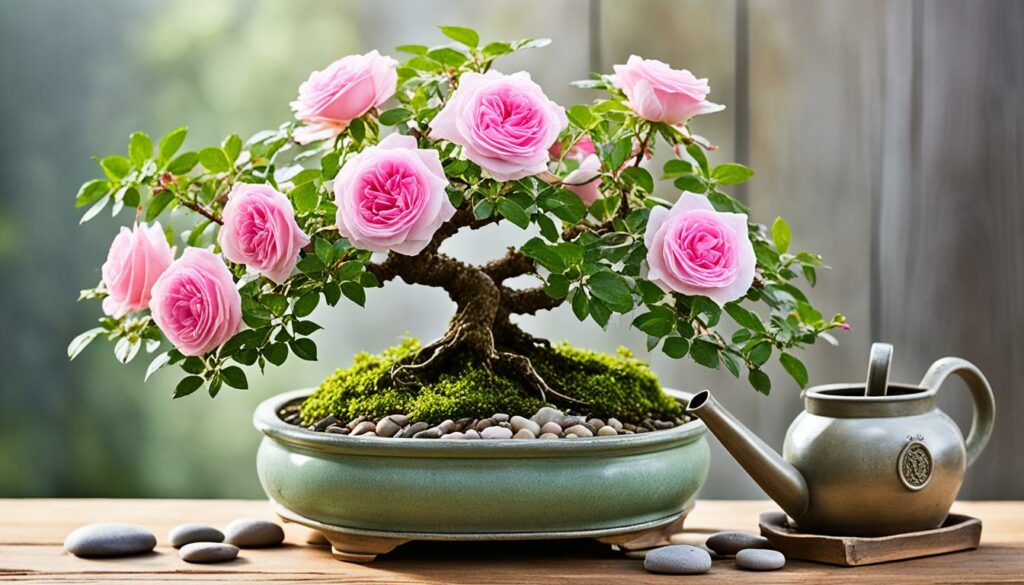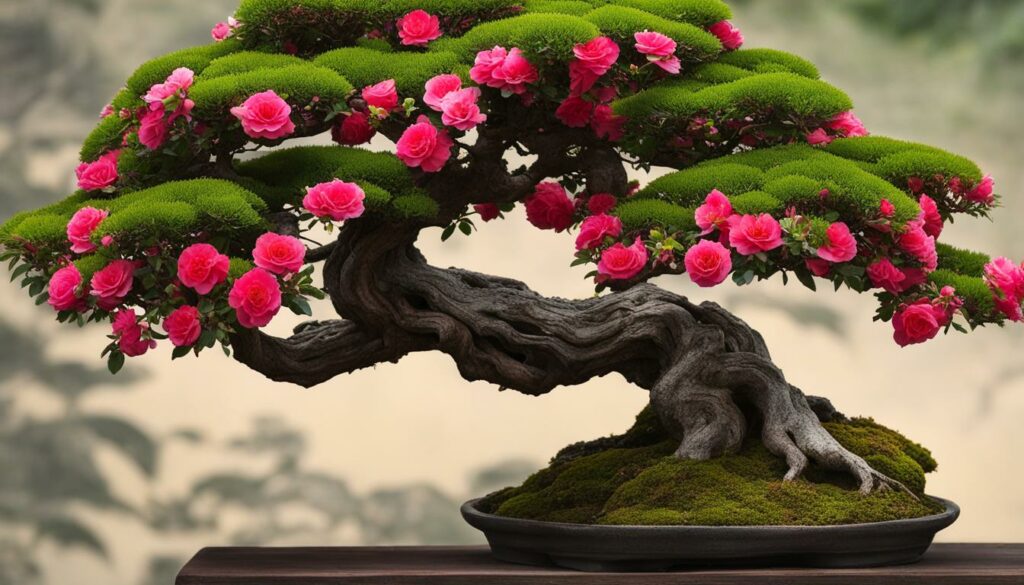Step into the breathtaking world of Bonsai Tree Species Rose. Experience the beauty of flowering bonsai and discover how these miniature masterpieces can arouse romantic feelings in any setting. You will be taken on a journey of refinement and elegance, exploring the intricacies of this unique combination of flora and art.
Key Takeaways
- Bonsai Tree Species Rose combines the elegance of the rose flower with bonsai artistry.
- Rose bonsai is a miniature version of the beloved flowering plant that brings beauty to any garden or home.
- Proper care and maintenance help bring out the full potential of your flowering bonsai.
- Growing and cultivating Rosa bonsai requires specialized knowledge and techniques.
- Bonsai Tree Species Rose is a timeless symbol of refinement and elegance.
The Beauty of Rose Bonsai
Transforming a delicate rose flower into a miniature version of itself through bonsai artistry is fascinating. The result is a mesmerizing display of beauty that can enhance any setting. There are different varieties that can be transformed into rose bonsai, each with its unique characteristics and visual impact.
Rosa chinensis, commonly known as China roses, are loved for their large, fragrant flowers that bloom in a range of colors from white to pink and red. They make excellent candidates for bonsai cultivation due to their hardiness and adaptability.
Rosa rugosa is a hardy species that produces colorful, fragrant flowers and dense foliage. Its rough bark and thorny stems make it an interesting bonsai specimen that can add visual texture and character to any garden or home decor.
Rosa banksiae, also known as Lady Banks’ Rose, is a climbing rose species that produces abundant yellow or white flowers in the spring. When cultivated as a bonsai, it forms an intricate, delicate-looking structure that adds a touch of elegance to any setting.
Discerning bonsai artists use intricate techniques to cultivate rose bonsai trees, including pruning, wiring, and shaping. For instance, wiring is used to bend and shape the rose plant’s stem and branches into the desired shape, while pruning helps maintain its size and form.
To create a rose bonsai, start by selecting a healthy rose plant with a thick stem and branches. You can then begin the process of shaping and directing its growth into a beautiful and unique bonsai tree.

“Rose bonsai is an intricate blend of delicate floral beauty and creative bonsai artistry that is sure to captivate anyone who beholds it.”
The Art of Flowering Bonsai
Creating a thriving flowering bonsai tree requires knowledge and skill. Follow these essential tips to bring out the full potential of your Bonsai Tree Species Rose and enjoy its blooming beauty year after year.
Pruning and Shaping Techniques
Proper pruning and shaping techniques are vital to encourage healthy growth and achieve the desired aesthetic appeal for your flowering bonsai. To shape your Rose bonsai, use small, precise cuts with a sharp pair of shears. Regularly remove dead, diseased or damaged branches and foliage to promote new growth.
Deadheading is also an essential pruning technique. Remove spent blooms promptly by cutting just above a healthy bud, and you will encourage the Flowering Bonsai to produce more buds. This practice helps to keep the tree healthy and maintains its beauty by promoting new growth.
Care and Maintenance
Ensure your bonsai gets the right balance of light, moisture and nutrients. Water daily, ensuring there is good drainage and avoid over watering. Overwatering can cause root rot and ultimately kill your bonsai. Place your bonsai in an area with plenty of natural light, but avoid direct sunlight, as this can dry out the tree. Remember, bonsai are grown in containers and need regular fertilizing to replace nutrients that become depleted over time. Follow recommended fertilizing and feeding schedules to promote healthy growth and blooming.
Dos and Don’ts for Flowering Bonsai Care
| Dos | Don’ts |
|---|---|
| Water consistently and keep the soil moist | Overwater, or underwater the tree |
| Provide plenty of natural light, but no direct sunlight | Expose to too much direct sunlight |
| Prune regularly with sharp shears | Use blunt or worn-out shears to prune |
| Remove dead or diseased branches and foliage | Allow dead or diseased foliage to remain |
| Fertilize and feed regularly | Over or under fertilize the bonsai |
Note: Avoid using tap water as it contains various minerals that could damage your bonsai over time. Instead, use filtered or distilled water.

Follow these guidelines and add intricate work, like wiring, repotting, and deadwood carving, to create your unique masterpiece. With proper care and maintenance, your Rosa bonsai can thrive and produce stunning blooms, bringing timeless beauty to any space.
Cultivating Rosa Bonsai
If you’re looking to add a touch of delicate beauty to your collection of Bonsai Tree Species Rose, it’s essential to learn how to successfully cultivate Rosa bonsai. These miniature roses require specific care and attention, but the stunning results are well worth the effort.
First, choose the variety of Rosa bonsai that best suits your preferences and location. Some popular options include the miniature China Rose, the bright and cheerful mini Polyantha, or the classic and elegant mini Hybrid Tea.

When it comes to caring for your Rosa bonsai, regular watering and fertilization are essential. Ensure your bonsai gets enough water, but not too much, as this can cause root rot. A balanced fertilizer with equal amounts of nitrogen, phosphorus, and potassium is ideal for promoting healthy growth and blooming.
Pruning is also crucial to maintaining the shape and health of your Rosa bonsai. Trim back any dead or damaged branches, and regularly prune back new growth to ensure the bonsai maintains its miniature size and structure.
Finally, it’s essential to be aware of the cultural significance of Rosa bonsai. These miniature roses symbolize love, devotion, and admiration, making them an ideal gift for a loved one or as a stunning addition to a romantic setting.
Conclusion
As you reflect on the immense beauty of Bonsai Tree Species Rose, you cannot help but appreciate its unique combination of floral elegance and bonsai artistry. The captivating charm of Rose bonsai is sure to enhance any romantic setting, whether it’s in your garden or home.
With the proper techniques and care, your flowering bonsai tree can thrive year after year, bringing out its full potential and stunning visual impact. Explore the various varieties of Rosa bonsai to find the perfect fit for your tastes and preferences.
Cultivating Rosa bonsai is an art form that requires patience and dedication, but it pays off with the delicate beauty of these miniature roses. With its rich history and symbolism, Rosa bonsai is a wonderful addition to any bonsai or floral collection.
So whether you’re an avid bonsai enthusiast or a lover of roses, Bonsai Tree Species Rose is an enchanting sight to behold. Its graceful allure is sure to capture your heart and enhance any space with its natural beauty and charm.
FAQ
What is a rose bonsai?
A rose bonsai is a miniature version of a rose tree that has been carefully cultivated and shaped using bonsai techniques. It combines the beauty of the rose flower with the artistry of bonsai cultivation, creating a stunning plant that can be enjoyed in a smaller, more manageable size.
Can any variety of rose be turned into a bonsai tree?
Yes, many different varieties of roses can be transformed into bonsai trees. However, certain characteristics, such as small flowers and compact growth habits, make some varieties more suitable for bonsai cultivation than others. It is essential to select a rose variety that is well-suited for bonsai techniques.
How do I care for a rose bonsai tree?
Caring for a rose bonsai tree involves regular watering, appropriate fertilization, pruning, and shaping. It is important to provide the tree with adequate sunlight and ensure proper drainage. Additionally, protecting the tree from extreme temperatures and pest infestation is crucial for its health and longevity.
Are rose bonsai trees difficult to grow?
Growing rose bonsai trees can be challenging, as they require specific care and attention. However, with proper knowledge and dedication, it is possible to cultivate healthy and thriving rose bonsai trees. It is important to learn the techniques and requirements specific to the variety of rose bonsai you choose to ensure successful growth.
What is the symbolism of Rosa bonsai?
Rosa bonsai, or rose bonsai, symbolizes love, beauty, and romance. The rose has long been associated with these sentiments, and when transformed into a bonsai tree, it carries these symbolic meanings in a miniature form. Rosa bonsai is often considered a unique and special gift to express deep affection and appreciation.


